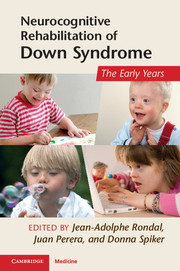Book contents
- Frontmatter
- Contents
- List of contributors
- Preface
- Acknowledgments
- Section 1 Definition, history, methodology, and assessment
- Section 2 Genetics, brain, and animal models
- Section 3 Pharmacological and medical management and treatment
- Section 4 Early development and intervention
- 10 Developmental models as frameworks for early intervention with children with Down syndrome
- 11 Aspects of motor development in Down syndrome
- 12 Memory development and learning
- 13 Prelinguistic and early development, stimulation, and training in children with Down syndrome
- 14 Speech perception, stimulation, and phonological development
- 15 Goal-directedness as a target for early intervention in Down syndrome
- 16 The role of parents of children with Down syndrome and other disabilities in early intervention
- Section 5 Therapeutic perspectives
- Conclusions
- Index
- References
11 - Aspects of motor development in Down syndrome
Published online by Cambridge University Press: 05 July 2011
- Frontmatter
- Contents
- List of contributors
- Preface
- Acknowledgments
- Section 1 Definition, history, methodology, and assessment
- Section 2 Genetics, brain, and animal models
- Section 3 Pharmacological and medical management and treatment
- Section 4 Early development and intervention
- 10 Developmental models as frameworks for early intervention with children with Down syndrome
- 11 Aspects of motor development in Down syndrome
- 12 Memory development and learning
- 13 Prelinguistic and early development, stimulation, and training in children with Down syndrome
- 14 Speech perception, stimulation, and phonological development
- 15 Goal-directedness as a target for early intervention in Down syndrome
- 16 The role of parents of children with Down syndrome and other disabilities in early intervention
- Section 5 Therapeutic perspectives
- Conclusions
- Index
- References
Summary
Introduction
In the first year of life, typically developing infants make huge strides in motor development. They progress from a limited repertoire of spontaneous and reflex movements to more purposeful, goal-directed movements. Using their arms, they achieve greater balance in more upright positions and progress from sitting and crawling to standing and walking. The rate of motor development is influenced by a number of factors including the maturation of the nervous system, individual/genetic make-up, the ability to process sensory stimulation such as touch, sound, vestibular, muscle and joint sensations, and movement experience within different environmental contexts. While movement experience has always been recognized as important for motor learning, it is only recently that evidence of the central nature of action experience on cognitive development is being explored. As a consequence, there is increased appreciation that infants learn rapidly from active experience and are able to transfer this knowledge to viewing the actions of others (Sommerville et al., 2005).
The onset of locomotion is one of the major transitions in early development and results in changes not only in motor skill but also in perception, spatial cognition, and social and emotional development (Campos et al., 2000). As infants become more mobile and start to explore their environment, they learn not only about their own bodies but also about objects, places, and events that have consequences for mobile exploration. Walking has tremendous implications on all areas of development. The opportunities for exploration, play, and interaction with peers increase significantly.
- Type
- Chapter
- Information
- Neurocognitive Rehabilitation of Down SyndromeEarly Years, pp. 153 - 163Publisher: Cambridge University PressPrint publication year: 2011



